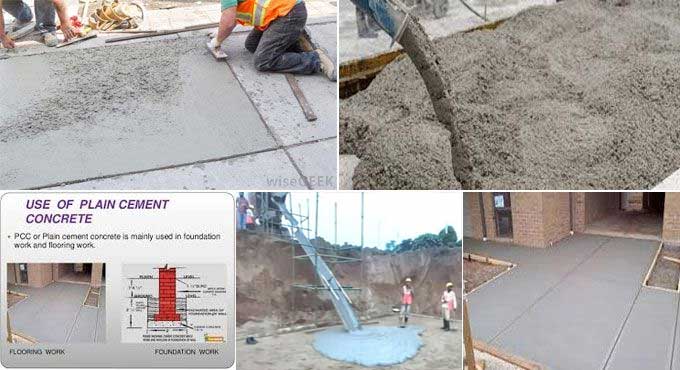
Analysis of Plain Cement Concrete in the foundation of a structure

Concrete made of plain cement is known as PCC or plain cement concrete. Plain cement concrete (PCC), which consists of cement, fine and coarse aggregates, is also known as Portland cement concrete.
PCC is usually laid directly on the excavated soil before any other work such as roofing or masonry is done directly on the surface in order to form a level surface and to avoid laying concrete directly on the soil so as to avoid mixing it directly with the soil and also in order to prevent soil extracting water from the PCC, thus causing it to become weaker.
Plain cement concrete is made using the following materials
Coarse Aggregate materials
Depending on where they are to be utilized, the size of the aggregate used for PCC ranges from 10 to 12 millimeters to 40 millimeters. The usage of cement is reduced when the aggregate size is greater. The coarse aggregate must be devoid of laminated, flaky, or elongated fragments.
Construction-related coarse aggregate must be composed mostly of granite or other similarly hard shattered stone that is free of impurities like dirt and dust. Use a 20 mm stone ballast that is equivalent in size to or smaller.
Any coarse material that is graded by the standard of more than forty percent is to be retained in a 5mm square mesh so it does not exceed the voids.
Fine Aggregate materials
To fine aggregate, a 5 mm square mesh filter should be utilized. Make sure that angular, sharp, and hard natural sand will flow through the screen. To ensure that no sea sand is utilized, the quality of the sand must be verified for any dust, debris, or organic matter.
Cement materials
PCC is usually made by using Portland Pozzolana Cement, which is also called PCC, as the main ingredient. The cement in question has several specifications, complies with the required ultimate strength, has a high compression strength, and is a product that has a high level of expertise.
Proper quantity of Water
It is the responsibility of the administrator to ensure that the quality of the water is maintained and that it is free of harmful substances like salts, acids, and alkalis that can interfere with the process. The pH scale of a clean water supply should indicate a value of at least 6 in order to ensure that it is suitable for use.
Types of Concrete mixed with plain cement
In order to mix PCC perfectly, there are two methods, either manually or with the help of machines:
Hand type mixing
In small-scale labor, the method of mixing PCC is often by hand. For mixing the concrete, use a steel platform, a waterproof slab, or a flat, clean surface. By adding sand and cement, the cement is properly mixed. Finally, water is properly added to the mixture and blended to produce uniformity and an equal hue.
Machine type mixing
Cement, fine aggregate, and dry coarse aggregate are all placed in a hopper in the exact calculated amounts. The dry ingredients need to be combined in a mixing drum. The procedure should be repeated a minimum of four times, after which the specified amount of water should be added gradually while the drum is in use.
As soon as 25% of the mixing time has elapsed, the water for mixing should be added in adequate amounts so that the desired cement-water ratio is achieved after 25% of the mixing time has passed. Several plastic mixtures of uniform colors are used in order to observe how the mixing process is going.
Curing methods
When it rains, it is important to make sure that newly built concrete is covered to prevent damage. The concrete starts to solidify after one to two hours. Sand, gunny bags, or quick-drying materials can be used to cover the concrete.
It is necessary to cure a surface that has been in place for more than 24 hours by either covering it with weight-absorbent materials or immersing it in water about 25mm deep. The minimum time required to accomplish a cure is more or less 10-14 days.
To learn more, watch the following video tutorial.
Video Source: Dr. Chirag N. Patel
Things to do while mixing the Plain Cement Concrete
1. A structural consultant should be consulted before PCC is installed in the foundation to ensure it's in compliance with the soil strata.
2. Size and thickness should be exact for PCC shuttering.
3. Water should be added to dry materials after they have been mixed uniformly.
4. It is important that water and cement are mixed in a measured amount according to the water-to-cement ratio.
5. Pour concrete where there is a greater depth by using a chute or an additional worker.
6. When concreting in areas with a high water table, de-watering should take place simultaneously.
Things not to do while mixing the Plain Cement Concrete
1. Never combine the components on bare ground.
2. Don't merely use a pipe to pour water into the materials. it is, with no measuring control.
3. The PCC must not be used without formwork.


